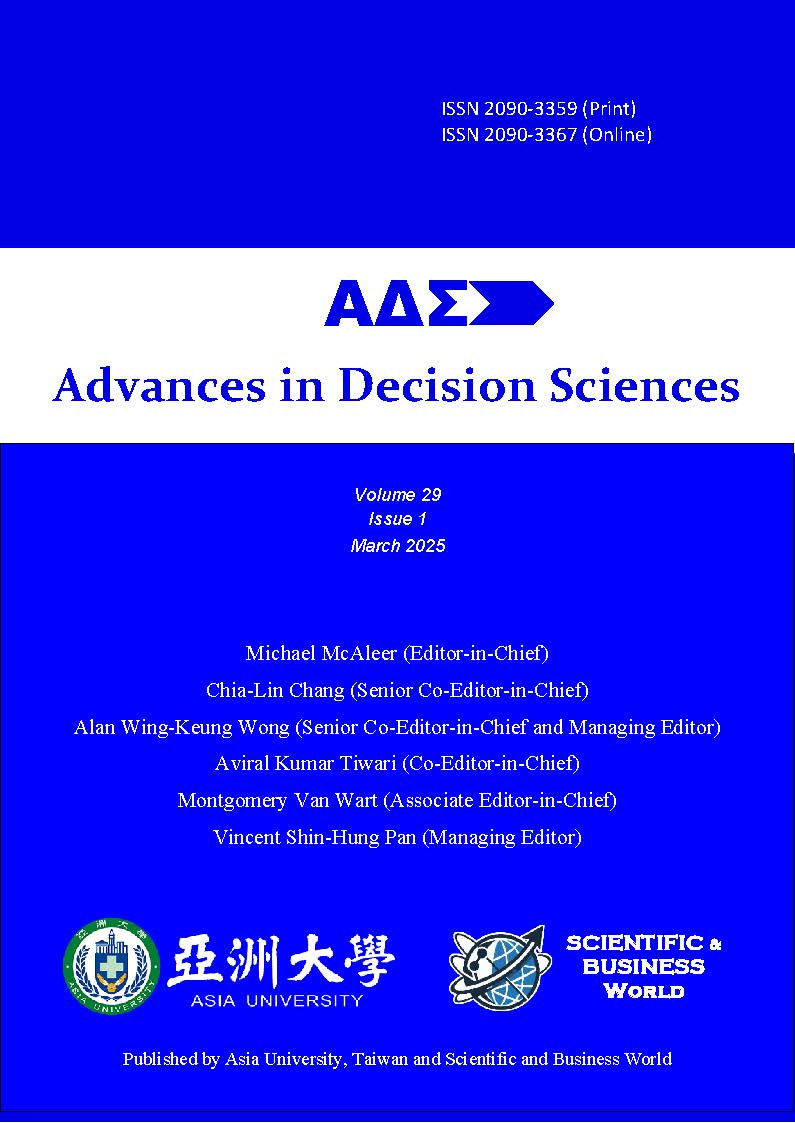Optimal stopping time strategy for paying tax
DOI:
https://doi.org/10.47654/v29y2025i1p55-82Keywords:
Optimal stopping problem, Markov processes, tax payment, reinvestment, penaltyAbstract
Purpose: In this study, we examine the strategic timing for paying corporate taxes under varying financial market conditions.
Design/methodology/approach: We develop a model by using optimal stopping theory and considering three tax regimes: (i) no tax, the firm is never required to pay taxes; (ii) paid tax on a monthly basis, taxes paid based on revenues periodically; and (iii) deferred tax with penalties, delaying taxes but incurring financial penalties.
Findings: Our results indicate that the optimal timing of tax payments is highly sensitive to market parameters such as drift, volatility, and the structure of tax penalties. The evidence further suggests that, under certain risk conditions, tax deferral can serve as a legitimate and value-enhancing strategy, allowing firms to retain more earnings and allocate resources more efficiently.
Originality: Our main contribution is to identify how timing strategies are shaped by drift, volatility, and tax penalties. The model is developed theoretically and supported by a Monte Carlo simulation. We also address the legal and policy implications of tax deferral, namely that under certain risk conditions, tax deferral increases firm value. Overall, our conclusions are based on mathematically rigorous modeling and simulations.
References
Assidi, S., Aliani, K., & Omri, M. A. (2016). Tax optimization and the firm’s value: Evidence from the Tunisian context. Borsa Istanbul Review, 16 (3), 177-184. https://doi.org/10.1016/j.bir.2016.04.002
Assidi, S., & Omri, M. A. (2017). Tax planning and payment timing. Afro-Asian Journal of Finance and Accounting, 7 (2), 164-176. https://doi.org/10.1504/AAJFA.2017.084227
Atwood, T. J., & Reynolds, J. K. (2008). The pricing of realized tax benefits from NOL carryforwards: Effect of income statement presentation. Journal of the American Taxation Association, 30 (1), 1-27. https://doi.org/10.2308/jata.2008.30.1.1
Auerbach, A. J., & Hines, J. R. (2002). Taxation and economic efficiency. In A. J. Auerbach & M. Feldstein(Eds.), Handbook of Public Economics, Vol. 3 (pp. 1347–1421). Elsevier. https://doi.org/10.1016/S1573-4420(02)80025-8
Badertscher, B., Kim, J., Kinney, W. R., & Owens, E. (2023). Assurance level choice, CPA fees, and financial
reporting benefits: Inferences from U.S. private firms. Journal of Accounting and Economics, 75 (1), 101551. https://doi.org/10.1016/j.jacceco.2022.101551
Barro, R. J. (1979). On the determination of the public debt. Journal of Political Economy, 87 (5), 940-971. https://doi.org/10.1086/260807
Basu, S. (1997). The conservatism principle and the asymmetric timeliness of earnings. Journal of Accounting and Economics, 24 (1), 3-37. https://doi.org/10.1016/S0165-4101(97)00014-1
Bayraktar, E., & Ludkovski, M. (2011). Optimal trade execution in illiquid financial markets. Mathematical Finance, 21 (4), 681–701. https://arxiv.org/abs/0902.2516
Copeland, T. E., & Keenan, P. T. (1998). How much is flexibility worth? The McKinsey Quarterly, 2, 118–129. https : //people.duke.edu/ charvey/T eaching/BA4562002/McK983.pdf
Dayanik, S., & Karatzas, I. (2003). On the optimal stopping problem for one-dimensional diffusions. Stochastic Processes and their Applications, 107 (2), 173-212. https://www.sciencedirect.com/science/article/pii/S0304414903000760
Desai, M. A., & Dharmapala, D. (2006). Corporate tax avoidance and high-powered incentives. Journal of Financial Economics, 79 (1), 145-179. https://doi.org/10.1016/j.jfineco.2005.02.002
De Angelis, T., Federico, S., & Ferrari, G. (2017). Optimal boundary surface for irreversible investment with stochastic costs. Mathematics of Operations Research, 42 (4), 1135-1161. https://doi.org/10.1287/moor.2016.0841
Dixit, A. K., & Pindyck, R. S. (1994). Investment under uncertainty. Princeton University Press. https://www.jstor.org/stable/j.ctt7sncv
Farhi, E., & Gabaix, X. (2020). Optimal taxation with behavioral agents. American Economic Review, 110 (1), 298-336. https://www.aeaweb.org/articles?id=10.1257/aer.20151079
Gollier, C. (2013). Pricing the planet’s future: The economics of discounting in an uncertain world. Princeton University Press. https://www.jstor.org/stable/j.cttq9rxs
Hanlon, M., & Heitzman, S. (2010). A review of tax research. Journal of Accounting and Economics, 50 (2-3), 127-178. https://doi.org/10.1016/j.jacceco.2010.09.00219
Kahneman, D., & Tversky, A. (1979). Prospect theory: An analysis of decision under risk. Econometrica, 47 (2), 263-291. https://doi.org/10.2307/1914185
Kahneman, D., & Riis, J. (2005). Living and thinking about it: Two perspectives on life. In E. Diener, D.
Kahneman, & J. F. Helliwell (Eds.), The Science of Well-Being (pp. 285-304). Oxford University Press. https://psycnet.apa.org/doi/10.1093/acprof:oso/9780198567523.003.0011
Kahneman, D., Sibony, O., & Sunstein, C. R. (2021). Noise: A flaw in human judgment. Little, Brown Spark.
LaFond, R., & Watts, R. L. (2008). The information role of conservative financial statements. The Accounting Review, 83 (2), 447-478. https://doi.org/10.2308/accr.2008.83.2.447
Marinovic, I., & Varas, F. (2019). Ceo horizon, optimal pay duration, and the escalation of short-termism. The Journal of Finance, 74 (4), 2011–2053. https://doi.org/10.1111/jofi.12770
Nobes, C., & Schwencke, H. R. (2007). Modelling the links between tax and financial reporting: A longitudinal examination of Norway over 30 years up to IFRS adoption. European Accounting Review, 15 (1), 63-87. https://doi.org/10.1080/09638180500510418
Øksendal, B., & Sulem, A. (2019). Applied Stochastic Control of Jump Diffusions (3rd ed.). Springer. https://doi.org/10.1007/978-3-030-02781-0
Peskir, G., & Shiryaev, A. (2006). Optimal stopping and free-boundary problems. Birkhäuser. https://doi.org/10.1007/978-3-7643-7390-0
Simon, H. A. (1986). Rationality in psychology and economics. Journal of Business, 59 (4), S209-S224. https://www.jstor.org/stable/2352757
Stolowy, H., & Breton, G. (2004). Accounts manipulation: A literature review and proposed conceptual framework. Review of Accounting and Finance, 3(1), 5-92. https://doi.org/10.1108/eb043395
Tang, T. Y. H., & Firth, M. (2012). Earnings persistence and stock market reactions to the different information in book-tax differences: Evidence from China. The International Journal of Accounting, 47 (3), 369–397. https://doi.org/10.1016/j.intacc.2012.07.004
Trigeorgis, L., & Reuer, J. J. (2017). Real options theory in strategic management. Strategic Management Journal, 38 (1), 42-63. https://doi.org/10.1002/smj.2593
Watts, R. L. (2003). Conservatism in accounting part I: Explanations and implications. Accounting Horizons, 17 (3), 207-221. https://doi.org/10.2308/acch.2003.17.3.207

Published
Issue
Section
License
Copyright (c) 2025 Advances in Decision Sciences

This work is licensed under a Creative Commons Attribution-NonCommercial 4.0 International License.



 Scientific and Business World
Scientific and Business World